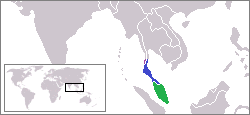
Barclaya is a genus of six species of flowering plants of the family Nymphaeaceae. Barclaya are aquatic plants native to tropical Asia. The genus was named in honour of the American-born English brewer and patron of science Robert Barclay.

Nymphaea mexicana is a species of aquatic plant that is native to the Southern United States and Mexico as far south as Michoacán. Common names include yellow water lily, Mexican water lily and banana water lily.

Euryale is a genus of flowering plants of the family Nymphaeaceae.
Nymphaea conardii is a species of waterlily native to the region spanning from Southern Mexico to tropical South America.
Nymphaea × thiona is a species of waterlily native to the US-American states Alabama, Florida, and Georgia. Additionally, it has been introduced to Costa Rica, as well as the US-American states Kentucky, and Nevada. It is a natural hybrid of Nymphaea mexicana and Nymphaea odorata.

Nymphaea gracilis is a species of waterlily endemic to Mexico. It is the only species of its genus which is endemic to Mexico.
Nymphaea guineensis is a species of waterlily native to the region spanning from tropical West Africa to Chad.
Nymphaea maculata is a species of waterlily native to tropical Africa.

Barclaya longifolia is a species of perennial aquatic plant native to the region of Indo-China to Northwest Peninsular Malaysia.
Passiflora aurantioides is a species of passion flower native to the region from the Maluku Islands, Indonesia, to Papuasia and Queensland, Australia.
Barclaya rotundifolia is a species of perennial aquatic plant native peninsular Malaysia, and Borneo.

Barclaya rugosa is a species of perennial aquatic plant endemic to peninsular Malaysia.

Barclaya wellyi is a species of perennial aquatic plant native to Sumatra, Indonesia.

Barclaya hirta is a species of aquatic plant native to Sumatra, Indonesia. It is disputed. By some, it is treated as synonym of Barclaya motleyi, but by others it is regarded as a separate species.
Barclaya kunstleri is a species of aquatic plant native to Peninsular Malaysia, and Singapore. It is disputed. By some, it is treated as synonym of Barclaya motleyi, but by others it is regarded as a separate species.
Nuphar ulvacea is a species of rhizomatous aquatic plant native to the US-American states Alabama and Florida.
Nuphar ozarkana is a species of aquatic plant native to the US-American states Arkansas, Missouri, and Oklahoma.
Nuphar orbiculata is a species of rhizomatous aquatic plant native to the US-American states Alabama, Florida, and Georgia.

Nymphaea subg. Brachyceras is a subgenus of the genus Nymphaea.

Nymphaea pygmaea is a controversial species of perennial, aquatic herb in the family Nymphaeaceae native to Asia.








